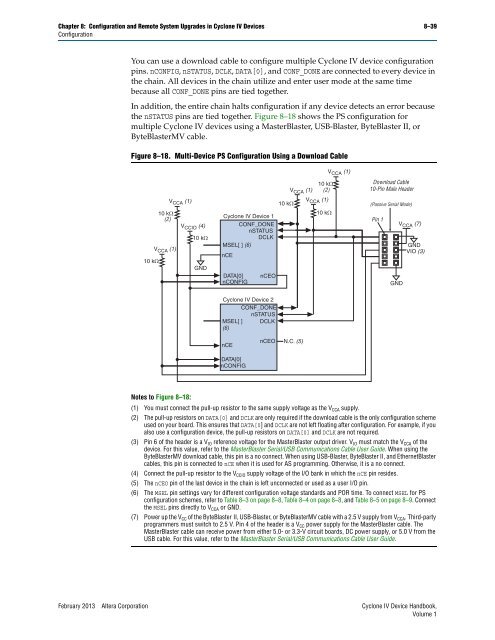Configuration and Remote System Upgrades in Cyclone IV ... - Altera
Configuration and Remote System Upgrades in Cyclone IV ... - Altera
Configuration and Remote System Upgrades in Cyclone IV ... - Altera
Create successful ePaper yourself
Turn your PDF publications into a flip-book with our unique Google optimized e-Paper software.
Chapter 8: <strong>Configuration</strong> <strong>and</strong> <strong>Remote</strong> <strong>System</strong> <strong>Upgrades</strong> <strong>in</strong> <strong>Cyclone</strong> <strong>IV</strong> Devices 8–39<br />
<strong>Configuration</strong><br />
You can use a download cable to configure multiple <strong>Cyclone</strong> <strong>IV</strong> device configuration<br />
p<strong>in</strong>s. nCONFIG, nSTATUS, DCLK, DATA[0], <strong>and</strong> CONF_DONE are connected to every device <strong>in</strong><br />
the cha<strong>in</strong>. All devices <strong>in</strong> the cha<strong>in</strong> utilize <strong>and</strong> enter user mode at the same time<br />
because all CONF_DONE p<strong>in</strong>s are tied together.<br />
In addition, the entire cha<strong>in</strong> halts configuration if any device detects an error because<br />
the nSTATUS p<strong>in</strong>s are tied together. Figure 8–18 shows the PS configuration for<br />
multiple <strong>Cyclone</strong> <strong>IV</strong> devices us<strong>in</strong>g a MasterBlaster, USB-Blaster, ByteBlaster II, or<br />
ByteBlasterMV cable.<br />
Figure 8–18. Multi-Device PS <strong>Configuration</strong> Us<strong>in</strong>g a Download Cable<br />
10 kΩ<br />
10 kΩ<br />
(2)<br />
V CCA (1)<br />
V CCA (1)<br />
Notes to Figure 8–18:<br />
V CCIO (4)<br />
10 kΩ<br />
GND<br />
<strong>Cyclone</strong> <strong>IV</strong> Device 1<br />
CONF_DONE<br />
nSTATUS<br />
DCLK<br />
MSEL[ ] (6)<br />
nCE<br />
DATA[0]<br />
nCONFIG<br />
<strong>Cyclone</strong> <strong>IV</strong> Device 2<br />
CONF_DONE<br />
nSTATUS<br />
MSEL[ ] DCLK<br />
(6)<br />
nCE<br />
DATA[0]<br />
nCONFIG<br />
(1) You must connect the pull-up resistor to the same supply voltage as the VCCA supply.<br />
(2) The pull-up resistors on DATA[0] <strong>and</strong> DCLK are only required if the download cable is the only configuration scheme<br />
used on your board. This ensures that DATA[0] <strong>and</strong> DCLK are not left float<strong>in</strong>g after configuration. For example, if you<br />
also use a configuration device, the pull-up resistors on DATA[0] <strong>and</strong> DCLK are not required.<br />
(3) P<strong>in</strong> 6 of the header is a VIO reference voltage for the MasterBlaster output driver. VIO must match the VCCA of the<br />
device. For this value, refer to the MasterBlaster Serial/USB Communications Cable User Guide. When us<strong>in</strong>g the<br />
ByteBlasterMV download cable, this p<strong>in</strong> is a no connect. When us<strong>in</strong>g USB-Blaster, ByteBlaster II, <strong>and</strong> EthernetBlaster<br />
cables, this p<strong>in</strong> is connected to nCE when it is used for AS programm<strong>in</strong>g. Otherwise, it is a no connect.<br />
(4) Connect the pull-up resistor to the VCCIO supply voltage of the I/O bank <strong>in</strong> which the nCE p<strong>in</strong> resides.<br />
(5) The nCEO p<strong>in</strong> of the last device <strong>in</strong> the cha<strong>in</strong> is left unconnected or used as a user I/O p<strong>in</strong>.<br />
(6) The MSEL p<strong>in</strong> sett<strong>in</strong>gs vary for different configuration voltage st<strong>and</strong>ards <strong>and</strong> POR time. To connect MSEL for PS<br />
configuration schemes, refer to Table 8–3 on page 8–8, Table 8–4 on page 8–8, <strong>and</strong> Table 8–5 on page 8–9. Connect<br />
the MSEL p<strong>in</strong>s directly to VCCA or GND.<br />
(7) Power up the VCC of the ByteBlaster II, USB-Blaster, or ByteBlasterMV cable with a 2.5 V supply from VCCA. Third-party<br />
programmers must switch to 2.5 V. P<strong>in</strong> 4 of the header is a VCC power supply for the MasterBlaster cable. The<br />
MasterBlaster cable can receive power from either 5.0- or 3.3-V circuit boards, DC power supply, or 5.0 V from the<br />
USB cable. For this value, refer to the MasterBlaster Serial/USB Communications Cable User Guide.<br />
February 2013 <strong>Altera</strong> Corporation <strong>Cyclone</strong> <strong>IV</strong> Device H<strong>and</strong>book,<br />
Volume 1<br />
nCEO<br />
nCEO<br />
VCCA (1)<br />
10 kΩ<br />
(2)<br />
10 kΩ<br />
VCCA (1)<br />
N.C. (5)<br />
10 kΩ<br />
V CCA (1)<br />
Download Cable<br />
10-P<strong>in</strong> Male Header<br />
(Passive Serial Mode)<br />
P<strong>in</strong> 1<br />
GND<br />
V CCA (7)<br />
GND<br />
VIO (3)
















